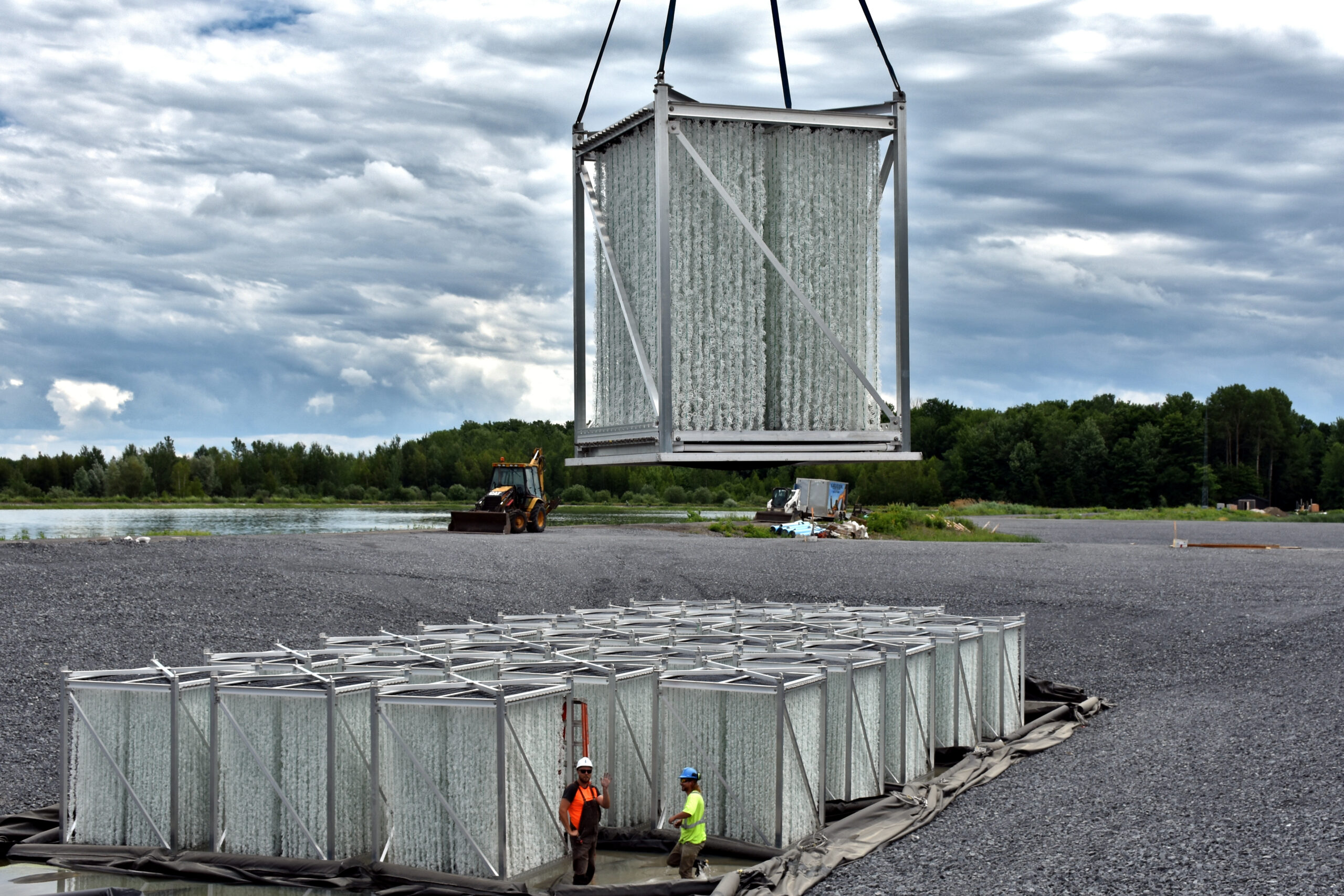With support from the Ontario Water Consortium’s Water Industry Growth Program, Bishop Water is advancing its award-winning BioCord Reactor technology, aiming to further optimize wastewater treatment efficiency, reduce energy consumption, and lower greenhouse gas emissions.
Bishop Water’s BioCord Reactor does an impressive job removing nutrients from wastewater. Each 2m x 2m x 2m unit is packed with media that creates lots of surface area for bacterial biofilms to grow on.
Because bacteria are the real work horses of sewage treatment, adding a few BioCord Reactors to a wastewater lagoon or treatment plant dramatically increases the system’s capacity and performance, without expanding its footprint.
The award-winning technology reduces ammonia levels by 90 per cent or more and biological oxygen demand (BOD) by at least 80 per cent. It also cuts total nitrogen levels in half. And by using compressors rather than high-powered blowers to give the bacteria the oxygen they need, Bishop Water has kept BioCord’s energy requirements low.
But CEO Kevin Bossy believes they can achieve those same results using even less energy — and generating less greenhouse gas emissions. To prove it, he’s partnered with wastewater treatment expert Dr. Martha Dagnew and her team of engineering researchers at Western University. And OWC’s Water Industry Growth (WIG) program is funding the collaboration.
Cutting costs and carbon footprints
The first step in the six-month project is to benchmark how much energy the BioCord Reactor currently consumes and the volume of greenhouse gas emissions it currently produces. Then, Dagnew and Bishop Water will look for ways to shrink those numbers.
One of the big things they’ll focus on is nitrous oxide (N2O), a potent greenhouse gas that can be generated when bacteria remove ammonia from the wastewater.
Bossy explains that reducing ammonia levels requires two types of bacteria: nitrifying bacteria and heterotrophic bacteria. Although both types are essential, they need different conditions to thrive.
Nitrifying bacteria require more oxygen and grow more slowly than heterotrophic bacteria. Each type of bacteria oxidizes different wastewater constituents, with nitrifiers preferring inorganic nitrogen and heterotrophs favouring organic carbon. Since wastewater often contains more organic compounds, and heterotrophs have a competitive advantage, it’s often challenging for nitrifiers to thrive.
By figuring out which operating conditions create the ideal balance of bacteria, Bossy aims to maximize ammonia removal while minimizing N2O production. That means playing with lots of parameters. “Can we change the oxygen level?” he says. “Can we be more intensive, less intensive with the mixing? Can we change the carbon-to-nitrogen ratios?”
That tinkering will take place at the Greenway Wastewater Treatment Plant in London, Ontario. The site’s demonstration facilities — co-run by Western University and the City of London, with funding from OWC — provide access to municipal wastewater flow and analytical equipment.
Next, the researchers will use simulation software to identify ways to reduce BioCord’s energy use — for example, by looking at different approaches to aeration. Finally, they’ll conduct a full life-cycle assessment, examining its total environmental impact from production to disposal.
Fuelling market growth
The results will give Bishop Water a marketing edge, providing further evidence that BioCord Reactors can enable communities to grow, while using less energy and limiting greenhouse gas emissions. As more municipalities and industries look to cut costs and meet carbon-reduction targets, these are big selling points. And they’ll become even more important as Canada and other countries impose stricter greenhouse gas limits in order to meet their net-zero commitments.
According to Bossy, OWC funding made this research possible. “Without the Ontario Water Consortium, I don’t think that we would have necessarily undertook this project,” he says. “And without the Ontario Water Consortium making that introduction to the University of Western Ontario, I’m not sure that we would have necessarily had such a great partner to work with.”
The WIG project is just the latest example of many years of OWC support. In the past, the Consortium helped Bishop Water establish a full-scale demonstration pilot of the BioCord Reactor in Dundalk, Ontario. Two subsequent projects funded through OWC’s Advancing Water Technology program verified BioCord’s effectiveness in cold-weather conditions, improved the system’s performance and optimized aeration.
All that has contributed to the company’s success. Since Bishop Water’s launch in 2008, the Eastern Ontario company has grown to 24 employees. It’s currently running demonstration pilots in Ontario, the United States, the Caribbean, Australia and New Zealand.
“We’ve had a tremendous amount of positive outcomes with OWC,” says Bossy. “They’ve been fabulous.”
WIG supports industry innovations that accelerate growth, create jobs and strengthen Ontario’s water sector. For more information, click here.


